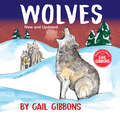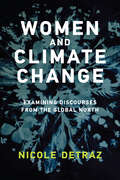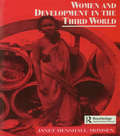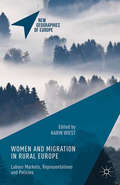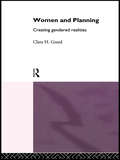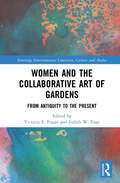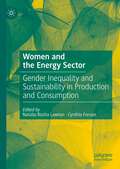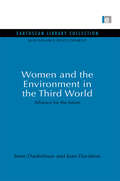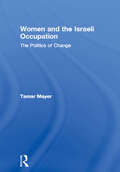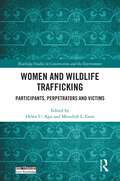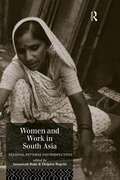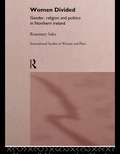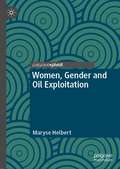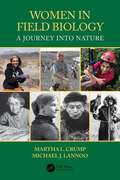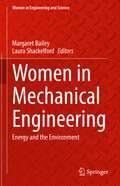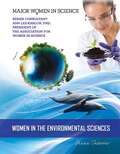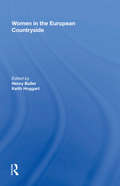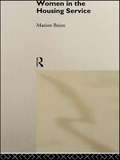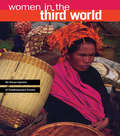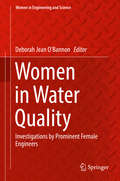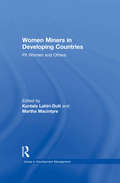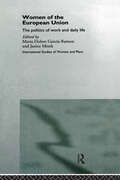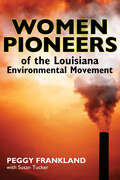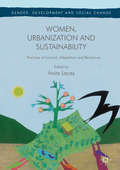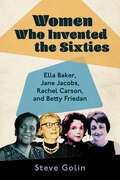- Table View
- List View
Wolves (New & Updated Edition)
by Gail GibbonsFrom the beloved science writer Gail Gibbons, rethink what you know about big bad wolves in this kid-friendly, illustrated guide with the latest facts from experts.While most people think of hungry fangs when they think of wolves, modern research has proven wolves are not the dangerous threat many thought them to be. This new edition, vetted by an expert, presents the latest scientific information on wolves in language accessible for young readers through vibrant, detailed illustrations and easy-to-read text. Kids will love seeing wolves roam the snowy, watercolor landscape while learning new, surprising facts about this often-misunderstood animal. Wolves tend to be shy and live peacefully among themselves in territories as large as 500 square miles. Pack leaders mate for life, and pack member hunt together, share food, and protect each other. See how wolves communicate with clearly labelled and expressive artwork. Read updated information on wolf hunting territories and the wolf pup development. Bonus pages include myths and legends about wolves, and a list of curious facts. Author of over 120 nonfiction books for kids, including the Gorillas and Migration, and with hundreds of thousands of books sold, Gail Gibbons continues to bring science to kids in this deep dive into the lives of wolves.
Women and Climate Change: Examining Discourses from the Global North
by Nicole DetrazHow ideas of gender and climate change intersect with our path to a livable future.When you think "climate change," who comes to mind? Who's doing the science, the reporting, the protesting, the suffering? In Women and Climate Change, Nicole Detraz asks where women in the Global North figure in the picture, what that means, and why it matters. Her answers fill critical gaps in what we know about the politics of climate change and gender.Representations of climate change, like perceptions of gender, can make a profound difference in understanding expectations and actions around social, cultural, and political issues. Interviewing women living in the Global North who work in the climate change sphere, Detraz examines the crucial links between notions of climate change and gender—in particular, how women are portrayed in climate change debates. Where is their presence or absence recognized? What tasks are they expected to perform? What factors influence their roles? The answers provide a nuanced account of the characteristics, conditions, and positions associated with women's activities in and experiences of climate change—a multifaceted portrayal of women that also demonstrates the generalization and essentializing that can hinder goals of sustainability and gender justice.Because gender is a social construction, Detraz reminds us, change is possible. Her book offers the suggestion, and the hope, that identifying connections between ideas of gender and climate change might also alter our vision of a livable future.
Women and Development in the Third World (Routledge Introductions to Development)
by Janet MomsenFor all societies, the common denominator of gender is female subordination. For women of the Third World the effects of this position are worsened by economic crisis, the legacy of colonialism, as well as patriarchal attitudes and economic crises.Feminist critique has introduced the gender factor to development theory, arguing that the equal distribution of the benefits of economic development can only be achieved through a radical restructuring of the process of development. This important new book reviews both policy and practice in Latin America, Africa and Asia and raises thought-provoking questions concerning the role of development planning and the empowerment of women.
Women and Migration in Rural Europe: Labour Markets, Representations and Policies (New Geographies of Europe)
by Karin WiestFundamental societal changes in the globalising European countryside impact women's migration decisions. The chapters in this volume represent diverse attempts to explain women's movements from rural areas, taking prevailing labour market conditions as well as gender relations into account. Utilising empirical findings from countries including Austria, Germany, Hungary, Poland, Romania and Spain, this collection particularly aims to build bridges between research following the 'cultural turn' and functionalist explanations which refer to material and practiced ruralities. The international range of contributors to Women and Migration in Rural Europe focus on societal constructions of gender and rurality, and in doing so, address various female perspectives on rural life. The analysis of the different working and living conditions in different parts of rural Europe reveals distinct obstacles but also prospects for young women. Importantly, the book includes policy implications with respect to the challenges of demographic change, questions of gender equality and women's contribution to rural development.
Women and Planning: Creating Gendered Realities
by Clara H. GreedPlanning is currently a male profession, but an analysis of a century of town planning reveals this to be a new development; women have been central to the planning movement since it began. Women and Planning is the first comprehensive history and analysis of women and the planning movement, covering the philosophical, practical and policy dimensions of `planning for women'. Beyond the marginalization of women, modern, scientific planning hides a story of past links with eugenics, colonialism, artistic, utopian and religious movements and the occult. Central to the discussion is the questioning of how male planners have rewritten planning in their own image, projecting patriarchal assumptions in their creation of `urban realities'. Issues of class, sexuality, ethnicity and disability are raised by the fundamental question of `Who is being planned for?'
Women and the Collaborative Art of Gardens: From Antiquity to the Present (Routledge Environmental Literature, Culture and Media)
by Victoria E. Pagán Judith W. PageWomen and the Collaborative Art of Gardens explores the garden and its agency in the history of the built and natural environments, as evidenced in landscape architecture, literature, art, archaeology, history, photography, and film. Throughout the book, each chapter centers the act of collaboration, from garden clubs of the early twentieth century as powerful models of women’s leadership, to the more intimate partnerships between family members, to the delicate relationship between artist and subject. Women emerge in every chapter, whether as gardeners, designers, owners, writers, illustrators, photographers, filmmakers, or subjects, but the contributors to this dynamic collection unseat common assumptions about the role of women in gardens to make manifest the significant ways in which women write themselves into the accounts of garden design, practice, and history. The book reveals the power of gardens to shape human existence, even as humans shape gardens and their representations in a variety of media, including brilliantly illuminated manuscripts, intricately carved architectural spaces, wall paintings, black and white photographs, and wood cuts. Ultimately, the volume reveals that gardens are best apprehended when understood as products of collaboration. The book will be of interest to scholars and students of gardens and culture, ancient Rome, art history, British literature, medieval France, film studies, women’s studies, photography, African American Studies, and landscape architecture.
Women and the Energy Sector: Gender Inequality and Sustainability in Production and Consumption
by Natalia Rocha Lawton Cynthia ForsonThis book explores the relationship between gender inequality and the energy business, examining how gender relates to the process of producing energy, the management of energy companies, and the consumption of energy in the public and private sphere. Drawing on a wide range of examples, from Africa, South Asia, Latin America and Europe, it examines how clean energy targets can transform the experience of women in the workplace, creating new opportunities and challenges. This book knits together a variety of voices probing continuing and emerging gender inequality in energy, from a number of perspectives, geography, energy dimensions, environment, socio-political and economic contexts. Its multidimensional approach provides a textured analysis of women’s experiences in the energy landscape, and proffers solutions for addressing the universality, yet contextually disparate impacts, of patriarchy and its intersections with another strands of inequality. It will be of great interest to academics studying energy capitalism, energy production, consumption, public policy and gender studies, as well as those practitioners and policymakers in the energy industry and relating to gender and equality in the workplace.
Women and the Environment in the Third World: Alliance for the future (Sustainable Development Set)
by Irene Dankelman Joan Davidson'This book ... should be issued to grass-root organisations everywhere' Doris Lessing, The New Scientist 'It is must reading for government planners, environmentalists and the ordinary layman' Asia Week Women in the Third World play the major role in managing natural resources. They are also the first and hardest hit by environmental mismanagement, yet they are neither consulted nor taken into account by development strategists. lrene Dankelman and Joan Davidson provide a clear account of the problems faced by women in the management of land, water, forests, energy and human settlements. They also describe the lack of response from international organizations. With the help of well-documented case studies they describe the ways in which women can organize to meet environmental, social and economic challenges. Originally published in 1988
Women and the Israeli Occupation: The Politics of Change (Routledge International Studies of Women and Place)
by Tamar MayerThe state of Israel and the Palestinian nation are at a monumental juncture in their histories. Both have a chance to claim a new future but more than a quarter of a century of occupation has had significant social, political, economic, cultural, psychological and moral ramifications for Israeli and Palestinian men and women.Women and the Israeli Occupation analyses the impact of the occupier/occupied dichotomy on the lives of Palestinian, Israeli Palestinian, and Israeli Jewish women. The book argues that the Occupation has exposed internal conflicts, challenging social structures within all three societies, but has also reinforced existing loyalties as Palestinian and Jewish women have moved into public political action and worked together to end the Occupation. It suggests that although military occupation is not colonialism, there are many similarities in the Israeli/Palestinian case.
Women and Wildlife Trafficking: Participants, Perpetrators and Victims (Routledge Studies in Conservation and the Environment)
by Helen U. AguThis volume examines women and wildlife trafficking via a bespoke collection of narratives, case studies and theoretical syntheses from diverse voices and disciplines. Wildlife trafficking has been documented in over one hundred and twenty countries around the world. While species extinction and animal abuse are major problems, wildlife trafficking is also associated with corruption, national insecurity, spread of zoonotic disease, undercutting sustainable development investments and erosion of cultural resources among others. The role of women in wildlife trafficking has remained woefully under-addressed, with scientists and policymakers failing to consider the important causes and consequences of the gendered dimensions of wildlife trafficking. Although the roles of women in wildlife trafficking are mostly unknown, they are not unknowable. This volume helps fill this lacuna by examining the roles and experiences of women with case studies drawn from across the world, including Mexico, Cameroon, the Central African Republic, South Africa and Norway. Women can be wildlife trafficking preventors, perpetrators, and pawns; their roles in both facilitating wildlife trafficking are considered from both a supply and a demand viewpoint. The first half of the book assesses the state of science, offering four different perspectives on how women and wildlife trafficking can be studied or evaluated. The second half of the book profiles diverse case studies from around the world, offering context-specific insight about on-the-ground activities associated with women and wildlife trafficking. This book will be of great interest to students and scholars of wildlife crime, conservation, gender studies, green criminology and environmental law. It will also be of interest to NGOs and policymakers working to improve efficacy of efforts targeting wildlife crime, the illegal wildlife trade, and conservation more broadly.
Women and Work in South Asia: Regional Patterns and Perspectives
by Saraswati Raju Deipica BagchiWomen's work is central to the social and economic aspirations of the countries of South Asia. Their contribution to agriculture, industry and services is critical. However, planners and policy makers frequently ignore women's economic roles, drawing simplistic conclusions from inadequate data. Women and Work in South Asia provides a cross-cultural perspective on research on women's work in South Asia. Integrating macro and micro analysis, Asian and Western contributors analyse the inadequacies of official statistics and explore, through case studies, the cultural and socio-economic position of women at work in the region.
Women Divided: Gender, Religion and Politics in Northern Ireland (Routledge International Studies of Women and Place)
by Rosemary SalesThe ongoing Irish peace process has renewed interest in the current social and political problems of Northern Ireland. In bringing together the issues of gender and inequality, Women Divided, a title in the International Studies of Women and Place series, offers new perspectives on women's rights and contemporary political issues. Women Divided argues that religious and political sectarianism in Northern Ireland has subordinated women. A historical review is followed by an analysis of the contemporary scene-- state, market (particularly employment patterns), family and church--and the role of women's movements. The book concludes with an in-depth critique of the current peace process and its implications for women's rights in Northern Ireland, arguing that women's rights must be a central element in any agenda for peace and reconciliation.
Women, Gender and Oil Exploitation (Gender, Development and Social Change)
by Maryse HelbertThis book examines the gender dimensions of large-scale mining in the oil industry and how oil exploitation has produced long-term economic, political, social and environmental risks and benefits in developing countries. It also shows that these risks and benefits have been unequally distributed between women and men. This project maps the ongoing dialogue between women’s issues and resource management, particularly, oil. The author attempts to answer the following questions: What are the impacts of oil projects on women in oil-rich countries? How can these impacts be explained? How can these impacts be reduced?
Women in Field Biology: A Journey Into Nature
by Martha L. Crump Michael J. LannooWomen are contributing to disciplines once the sole domain of men. Field biology has been no different. The history of women field biologists, embedded in a history largely made and recorded by men, has never been written. <p><p>Compilations of biographies have been assembled, but the narrative—their story—has never been told. In part, this is because many expressed their passion for nature as writers, artists, collectors, and educators during eras when women were excluded from the male-centric world of natural history and science. The history of women field biologists is intertwined with men’s changing views of female intellect and with increasing educational opportunities available to women. Given the preponderance of today’s professional female ecologists, animal behaviorists, systematists, conservation biologists, wildlife biologists, restoration ecologists, and natural historians, it is time to tell this story—the challenges and hardships they faced and still face, and the prominent role they have played and increasingly play in understanding our natural world. <p><p> For a broader perspective, we profile selected European women field biologists, but our primary focus is the journey of women field biologists in North America. Each woman highlighted here followed a unique path. For some, personal wealth facilitated their work; some worked alongside their husbands. Many served as invisible assistants to men, receiving little or no recognition. Others were mavericks who carried out pioneering studies and whose published works are still read and valued today. <p><p>All served as inspiration and proved to the women who would follow that women are as capable as men at studying nature in nature. Their legacy lives on today. The 75 female field biologists interviewed for this book are further testament that women have the intellect, stamina, and passion for fieldwork.
Women in Mechanical Engineering: Energy and the Environment (Women in Engineering and Science)
by Margaret Bailey Laura ShackelfordThis book features influential scholarly research and technical contributions, professional trajectories, disciplinary shifts, personal insights, and a combination of these from a group of remarkable women within mechanical engineering. Combined, these chapters tell an important story about the dynamic field of mechanical engineering in the areas of energy and the environment, as seen from the perspective of some of its most extraordinary women scientists and engineers. The volume shares with the Women in Engineering and Science Series the primary aim of documenting and raising awareness of the valuable, multi-faceted contributions of women engineers and scientists, past and present, to these areas. Women in mechanical engineering and energy and the environment are historically relevant and continue to lead these fields as passionate risk takers, entrepreneurs, innovators, educators, and researchers. Chapter authors are members of the National Academies, winners of major awards and recognition that include Presidential Medals, as well as SWE, SAE, ASME, ASEE and IEEE Award winners and Fellows.
Women in the Environmental Sciences (Major Women in Science #10)
by Shaina IndovinoWomen have made major contributions to science throughout history, including in the environmental sciences. Learn about the lives of some of the most amazing women in environmental science, from Rachel Carson to Lena Ma, as well as their exciting and important work. Discover what it takes to work in the environmental sciences. Find out about the opportunities for women in the field. Read Women in the Environmental Sciences to see if following in the footsteps of the many brilliant women who have made their mark in environmental science is something you want to do.
Women in the European Countryside (Perspectives On Rural Policy And Planning Ser.)
by Henry BullerMuch of the literature published so far on gender relations in rural areas has either focused on comparisons of the position of men and women, or explored the position of women given prevailing structural forces and behavioural 'norms' that restrict the autonomy of women as human agents. This groundbreaking book broadens the debate by developing our understanding of how societal processes produce and sustain gender divisions, particularly in rural areas, highlighting aspects of rural women's lives previously invisible in the literature. Illustrated by case studies from France, Germany, Greece, Norway and Sweden, the book examines the critical issues of education and training, entrepreneurship, leadership, limited work and service opportunities, social mobility, and work experiences. In doing so, the contributors provide a fascinating comparative study of both national-regional and broader European realities.
Women in the Housing Service
by Marion BrionThis book explores the contribution of women to the development of housing management in the 20th century. It outlines tactics and strategies of organization and factors which have seemed to help or hinder women's participation in housing. Evidence from statistical sources, historical documents and personal interviews is also assessed. Throughout the discussion, key issues are linked to current trends in the 1990s, making this volume suitable as a source of reference for students and researchers in housing and related fields.
Women in the Third World: An Encyclopedia of Contemporary Issues
by Nelly P. Stromquist Karen MonkmanIdeal for researching the status and activities of Third World womenFor quick, reliable coverage of women's issues in developing countries, here is a concise reference work written by a team of more than 80 international experts. The Encyclopedia comprises 68 essays that cover the entire Third World, from Africa to Asia, from the Near East to South and Central America, from the South Pacific to the Caribbean. The women authors are acknowledged experts from Harvard University, the World Bank, the United Nations Development Fund for Women, the University of Nairobi, the International Labor Organization, and other institutions, who summarize the most recent scholarship on a wide range of important subjects. Thoroughly indexed and cross-referenced, the Encyclopedia is an ideal starting point for in-depth research in such areas as:recent developments in the prevention of violence against women * the conditions of women's lives across regions and countries * women's participation in government, science, and technology * hidden curriculum issues in higher education * an overview of women's experiences as small-scale entrepreneursA feminist viewpoint enhances the coverageInformed throughout by a feminist perspective, the Encyclopedia focuses on traditional women's concerns, such as political participation, human rights, nutrition, housework, the family, equality, health, and more. But the coverage also extends to such issues as domestic and sexual violence, creation of women-friendly cities, patriarchal ideologies as religious beliefs, the needs of older women, new jobs and exploitation in industrial production, AIDS, the gender consequences of ecological devastation, movements for change, and other areas of increasing awareness. Geographical entries cover all the major regions and countries and discuss conditions and issues in each area.Spotlights the newest and best sourcesThe Encyclopedia brings together information that has been widely scattered in sources from many disciplines. An introduction by the editor illuminates the most important issues faced by Third World women today and analyzes the drastically changed global situation and how the changes impacted on the material presented in the Encyclopedia.Reference aids make information retrieval easyAn annotated bibliography of the latest and most important sources, as well as a reference list at the end of each chapter, provide quick access to current literature. A thorough name and subject index makes it easy to pinpoint information.Special FeaturesOffers articles by recognized scholars and activists on gender and developmental issues * Presents a variety of perspectives by women from both industrialized and developing countries * Summarizes the literature of established disciplines, bringing together important material scattered in many sources * Identifies new areas for research affecting gender and development in emerging fields, such as legal rights * Outlines strategies for action in such critical areas as ecology and urban issues * An annotated bibliography and list of references at end of each chapter make it easy to expand your research
Women in Water Quality: Investigations by Prominent Female Engineers (Women in Engineering and Science)
by Deborah Jean O’BannonThis volume captures the impact of women’s research on the public health and environmental engineering profession. The volume is written as a scholarly text to demonstrate that women compete successfully in the field, dating back to 1873. Each authors’ chapter includes a section on her contribution to the field and a biography written for a general audience. This volume also includes a significant representation of early women’s contributions, highlighting their rich history in the profession. The book covers topics such as drinking water and health, biologically-active compounds, wastewater management, and biofilms. This volume should be of interest to academics, researchers, consulting engineering offices, and engineering societies while also inspiring young women to persist in STEM studies and aspire to academic careers.Features a blend of innovations and contributions made by women in water quality engineering, as well as their path to success, including challenges in their journeysPresents an opportunity to learn about the breadth and depth of the field of water qualityIncludes a history of women in water quality engineering as well as research in current issues such as urban water quality, biologically-active compounds, and biofilms
Women Miners in Developing Countries: Pit Women and Others (Voices in Development Management)
by Martha MacintyreContrary to their masculine portrayal, mines have always employed women in valuable and productive roles. Yet, pit life continues to be represented as a masculine world of work, legitimizing men as the only mineworkers and large, mechanized, and capitalized operations as the only form of mining. Bringing together a range of case studies of women miners from past and present in Asia, the Pacific region, Latin America and Africa, this book makes visible the roles and contributions of women as miners. It also highlights the importance of engendering small and informal mining in the developing world as compared to the early European and American mines. The book shows that women are engaged in various kinds of mining and illustrates how gender and inequality are constructed and sustained in the mines, and also how ethnic identities intersect with those gendered identities.
Women of the European Union: The Politics of Work and Daily Life (Routledge International Studies of Women and Place)
by Maria Dolors Garc Janice MonkWomen of the European Union challenges gender-blind assessments of the economic and social aspects of the European Union policies to examine the real implications of Union for the diversity of women in the Member States.The authors also analyze how women's work and daily lives are shaped by local and national policies, by local and global economic conditions, and by diverse and changing cultural values.Detailed contemporary case studies explore how place comes together with class, life stage, sexuality and ethnicity to affect the way in which women are constrained and how they develop strategies to manage their lives.
Women Pioneers of the Louisiana Environmental Movement
by Peggy FranklandWomen Pioneers of the Louisiana Environmental Movement provides a window into the passion and significance of thirty-eight committed individuals who led a grassroots movement in a socially conservative state. The book is comprised of oral history narratives in which women activists share their motivation, struggles, accomplishments, and hard-won wisdom. Additionally interviews with eight men, all leaders who worked with or against the women, provide more insight into this rich--and also gendered--history.The book sheds light on Louisiana and America's social and political history, as well as the national environmental movement in which women often emerged to speak for human rights, decent health care, and environmental protection. By illuminating a crucial period in Louisiana history, the women tell how "environmentalism" emerged within a state already struggling with the dual challenges of adjusting to the civil rights movement and the growing oil boom.Peggy Frankland, an environmental activist herself since 1982, worked with a team of interviewers, especially those trained at Louisiana State University's T. Harry Williams Center for Oral History. Together they interviewed forty women pioneers of the state environmental movement. Frankland's work also was aided by a grant from the Louisiana Endowment for the Humanities. In this compilation, she allows the women's voices to provide a clear picture of how their smallest actions impacted their communities, their families, and their way of life. Some experiences were frightening, some were demeaning, and many women were deeply affected by the individual persecution, ridicule, and scorn their activities brought. But their shared victories reveal the positive influence their activism had on the lives of loved ones and fellow citizens.
Women, Urbanization and Sustainability
by Anita LaceyThis work considers the city as a gendered space and examines women’s experiences and engagement in both urbanization and sustainability. Such a focus offers distinctive insights into the question of what it means for a city to be sustainable, asking further how sustainability needs to work with gender and the gendered lives of cities’ inhabitants. Vitally, it considers women’s lives in cities and their work to forge more sustainable cities through a wide variety of means, including governmental, non-governmental and local grassroots and individual efforts towards sustainable urban life. The volume is transnational, offering case-studies from a wide range of city sites and sustainability efforts. It explores crucial questions such as the gendered nature and women’s experiences of current urbanization; the gendered nature of urban sustainability thinking and programmes; and local alternatives and resistances to dominant modes of addressing urbanization challenges.
Women Who Invented the Sixties: Ella Baker, Jane Jacobs, Rachel Carson, and Betty Friedan
by Steve GolinWhile there were many protests in the 1950s—against racial segregation, economic inequality, urban renewal, McCarthyism, and the nuclear buildup—the movements that took off in the early 1960s were qualitatively different. They were sustained, not momentary; they were national, not just local; they changed public opinion, rather than being ignored. Women Who Invented the Sixties tells the story of how four women helped define the 1960s and made a lasting impression for decades to follow. In 1960, Ella Baker played the key role in the founding of the Student Nonviolent Coordinating Committee, which became an essential organization for students during the civil rights movement and the model for the antiwar and women’s movements. In 1961, Jane Jacobs published The Death and Life of Great American Cities, changing the shape of urban planning irrevocably. In 1962, Rachel Carson published Silent Spring, creating the modern environmental movement. And in 1963, Betty Friedan wrote The Feminine Mystique, which sparked second-wave feminism and created lasting changes for women. Their four separate interventions helped, together, to end the 1950s and invent the 1960s.Women Who Invented the Sixties situates each of these four women in the 1950s—Baker’s early activism with the NAACP and the Southern Christian Leadership Conference, Jacobs’s work with Architectural Forum and her growing involvement in neighborhood protest, Carson’s conservation efforts and publications, and Friedan’s work as a labor journalist and the discrimination she faced—before exploring their contributions to the 1960s and the movements they each helped shape.
